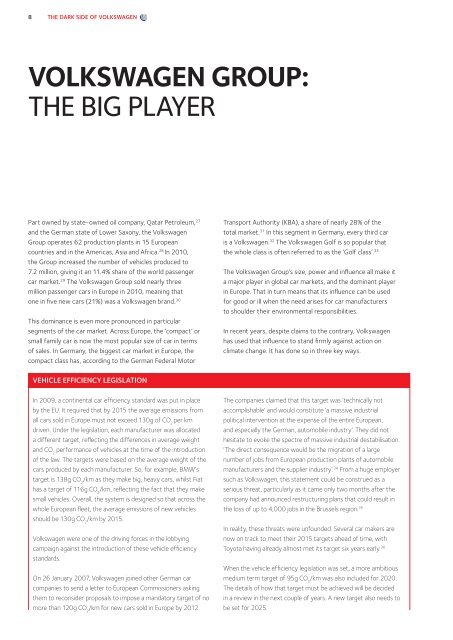The Dark Side of Volkswagen - Greenpeace
The Dark Side of Volkswagen - Greenpeace
The Dark Side of Volkswagen - Greenpeace
You also want an ePaper? Increase the reach of your titles
YUMPU automatically turns print PDFs into web optimized ePapers that Google loves.
8 THE DARK SIDE OF VOLKSWAGEN<br />
VolKSwAgEn gRoUp:<br />
ThE bIG plAyEr<br />
Part owned by state-owned oil company, Qatar Petroleum, 27<br />
and the German state <strong>of</strong> Lower Saxony, the <strong>Volkswagen</strong><br />
Group operates 62 production plants in 15 European<br />
countries and in the Americas, Asia and Africa. 28 In 2010,<br />
the Group increased the number <strong>of</strong> vehicles produced to<br />
7.2 million, giving it an 11.4% share <strong>of</strong> the world passenger<br />
car market. 29 <strong>The</strong> <strong>Volkswagen</strong> Group sold nearly three<br />
million passenger cars in Europe in 2010, meaning that<br />
one in five new cars (21%) was a <strong>Volkswagen</strong> brand. 30<br />
This dominance is even more pronounced in particular<br />
segments <strong>of</strong> the car market. Across Europe, the ‘compact’ or<br />
small family car is now the most popular size <strong>of</strong> car in terms<br />
<strong>of</strong> sales. In Germany, the biggest car market in Europe, the<br />
compact class has, according to the German Federal Motor<br />
VEHICLE EFFICIENCY LEGISLATION<br />
In 2009, a continental car efficiency standard was put in place<br />
by the EU. It required that by 2015 the average emissions from<br />
all cars sold in Europe must not exceed 130g <strong>of</strong> CO 2 per km<br />
driven. Under the legislation, each manufacturer was allocated<br />
a different target, reflecting the differences in average weight<br />
and CO 2 performance <strong>of</strong> vehicles at the time <strong>of</strong> the introduction<br />
<strong>of</strong> the law. <strong>The</strong> targets were based on the average weight <strong>of</strong> the<br />
cars produced by each manufacturer. So, for example, BMW‘s<br />
target is 138g CO 2 /km as they make big, heavy cars, whilst Fiat<br />
has a target <strong>of</strong> 116g CO 2 /km, reflecting the fact that they make<br />
small vehicles. Overall, the system is designed so that across the<br />
whole European fleet, the average emissions <strong>of</strong> new vehicles<br />
should be 130g CO 2 /km by 2015.<br />
<strong>Volkswagen</strong> were one <strong>of</strong> the driving forces in the lobbying<br />
campaign against the introduction <strong>of</strong> these vehicle efficiency<br />
standards.<br />
On 26 January 2007, <strong>Volkswagen</strong> joined other German car<br />
companies to send a letter to European Commissioners asking<br />
them to reconsider proposals to impose a mandatory target <strong>of</strong> no<br />
more than 120g CO 2 /km for new cars sold in Europe by 2012.<br />
Transport Authority (KBA), a share <strong>of</strong> nearly 28% <strong>of</strong> the<br />
total market. 31 In this segment in Germany, every third car<br />
is a <strong>Volkswagen</strong>. 32 <strong>The</strong> <strong>Volkswagen</strong> Golf is so popular that<br />
the whole class is <strong>of</strong>ten referred to as the ‘Golf class’. 33<br />
<strong>The</strong> <strong>Volkswagen</strong> Group’s size, power and influence all make it<br />
a major player in global car markets, and the dominant player<br />
in Europe. That in turn means that its influence can be used<br />
for good or ill when the need arises for car manufacturers<br />
to shoulder their environmental responsibilities.<br />
In recent years, despite claims to the contrary, <strong>Volkswagen</strong><br />
has used that influence to stand firmly against action on<br />
climate change. It has done so in three key ways.<br />
<strong>The</strong> companies claimed that this target was ‘technically not<br />
accomplishable’ and would constitute ‘a massive industrial<br />
political intervention at the expense <strong>of</strong> the entire European,<br />
and especially the German, automobile industry’. <strong>The</strong>y did not<br />
hesitate to evoke the spectre <strong>of</strong> massive industrial destabilisation.<br />
‘<strong>The</strong> direct consequence would be the migration <strong>of</strong> a large<br />
number <strong>of</strong> jobs from European production plants <strong>of</strong> automobile<br />
manufacturers and the supplier industry’. 34 From a huge employer<br />
such as <strong>Volkswagen</strong>, this statement could be construed as a<br />
serious threat, particularly as it came only two months after the<br />
company had announced restructuring plans that could result in<br />
the loss <strong>of</strong> up to 4,000 jobs in the Brussels region. 35<br />
In reality, these threats were unfounded. Several car makers are<br />
now on track to meet their 2015 targets ahead <strong>of</strong> time, with<br />
Toyota having already almost met its target six years early. 36<br />
When the vehicle efficiency legislation was set, a more ambitious<br />
medium term target <strong>of</strong> 95g CO 2 /km was also included for 2020.<br />
<strong>The</strong> details <strong>of</strong> how that target must be achieved will be decided<br />
in a review in the next couple <strong>of</strong> years. A new target also needs to<br />
be set for 2025.

















